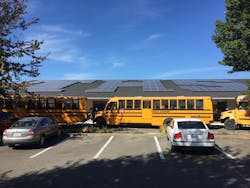A group effort by Puget Sound Energy, the city of Tenino, Wash., a nonprofit organization, and others has yielded plans for a utility-owned microgrid that can island and provide power to the Tenino School District.
Under the effort, called the Tenino Innovation and Education Through Renewables (TIER) project, numerous funders are backing a solar microgrid that uses behind-the-meter solar owned by the school district plus assets owned by the utility, said Tanya Barham, director of operations and product development for PECI, a nonprofit organization that has played a major role in organizing the effort.
Ultimately, the goal is to create a project that teaches local students and residents about innovative energy technologies and encourages them to pursue careers in the field.
“The objective is to make Tenino a living lab for K-12 students to learn about clean energy and also move into tech education, then go to work for clean energy providers in the region,” Barham said. Part of the aim is to create jobs to replace those that will be lost when when the Centralia Coal Plant, owned by TransAlta, closes in 2025.
The microgrid will include 64 kW of behind-the-meter solar owned by the Tenino School District, plus assets owned by Puget Sound Energy: 150 kW of solar, a 1-MW battery, a substation and transmission lines. During a major blackout, all those assets will be used to provide power to the school district.
In addition, two-way communication between the utility and homeowners will be established for demand response programs, said Barham.
The project has its roots in an idea hatched by David Watterson, a Tenino City Council member.
He was interested in bringing more renewable energy to the city and knew that the state offered grants for schools. In addition, Trans Alta was offering funding for energy efficiency projects as part of its Centralia coal-plant shutdown agreement with environmentalists and others.
Working with the school district and a local installer, Watterson helped obtain $350,000 in grant funding from the state and TransAlta for the 64-kW solar system at the school.
But he wanted to take the project further, providing education, grid reliability and backup power. He learned about PECI, which aims to innovate the grid for public and environmental benefits.
“With the help of PECI, we developed a program focused on education and grid reliability and backup power for our high school in case of emergency,” he said.
The city partnered with Puget Sound Energy to test smart grid models and technologies, he said.
Anatomy of the utility-owned microgrid
The utility-owned microgrid will use a Puget Sound substation, the utility-owned battery, and the 150 kW of solar to be built on utility-owned land adjacent to the substation, Barham said.
“With the substation, battery and solar, there’s an opportunity to test what would happen in an emergency,” said Barham.
If there were a major blackout in the West, for example, knocking out the three transmission lines that serve the area, the utility- and school-owned solar would energize the battery and a line that goes to the high school, located near the substation, she said.
“Anything on that line would continue to be energized and the school’s solar wouldn’t shut down; it’s like a subpanel,” she said. “It would disconnect from the grid, and rely on some infrastructure owned by the utility and some by the school. It would create its own grid using the battery, the solar and the transmission line.”
Funding for the TIER project has also come from the Bonneville Environmental Foundation. The project organizers are now seeking additional grant money for the project, estimated to cost about $7 million.
Learn about the latest public, private and utility-owned microgrid projects. Join us at Microgrid 2019, May 14-16 in San Diego, Calif.
Demand response that trusts homeowners
An additional goal of the project is to establish two-way communication between the utility and residents, with an aim of creating a demand response program that gives homeowners more control than other demand response programs, said Barham. The goal would be to aggregate behind-the-meter demand response.
Under this program, residents will use a home energy management controller that controls individual devices. Homes will be equipped with electric water heaters, batteries and other devices that can be controlled for demand response. The program will be based on research done at the Pacific Northwest National Laboratory that created ways to predict demand response events and forecast how homeowners would respond, said Barham.
“Instead of utilities controlling the devices, this program will look at how homeowners’ behavior can give a trustworthy commitment to the grid,” she said.
A model for small communities
The TIER and home energy management programs show how small communities can be innovators, said Watterson.
“It’s all about how can we train our youth, who will ultimately make the big changes we need to protect the environment,” he said.
The project has received in-kind support and a $60,000 grant from Bonneville Environmental Foundation and has the backing of the Pacific Northwest Center of Excellence for Clean Energy at Centralia College, plus others, according to a press release from PECI and the city. TIER is now applying for more than $4 million in funding from TransAlta and the Washington Department of Commerce’s Clean Energy Fund.
Track news about public, private and utility-owned microgrid projects. Subscribe to the free Microgrid Knowledge newsletter.








